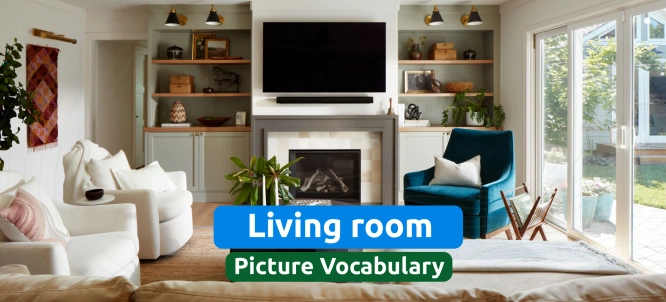by PushtoLearn
Living room
Table of Contents
Living Room - A1 Exercise
This exercise focuses on Living Room vocabulary
What is a Living Room?
A living room is a room in the house where people relax, watch TV, read, and enjoy time together. It’s often the biggest room in the house, with comfortable furniture and entertainment like a TV or music system.
Here’s a list of common things you’ll find in a living room:
|
Item |
Purpose |
|
Sofa or Couch |
For sitting and relaxing |
|
TV |
For watching shows and movies |
|
Coffee Table |
For placing drinks, snacks, and books |
|
Lamp |
For lighting the room |
|
Bookshelf |
For storing books and decorations |
|
Armchair |
A single comfortable chair for one person |
|
Carpet or Rug |
A soft covering on the floor |
|
Curtains |
Fabric that covers windows |
|
Pictures/Art |
Decorations for the walls |

Basic Living Room Vocabulary
Learning living room vocabulary helps kids describe what’s in the room and what each item is for. Here are some useful words:
-
Furniture: Items we sit on or use in the room, like a sofa, table, or chair.
-
Decorations: Things that make the room look nice, like paintings or plants.
-
Entertainment: Things we use for fun, like the TV or books.
-
Comfortable: Something that feels good to use or sit on, like a cozy sofa or chair.
Describing the Living Room
To describe the living room, we talk about its furniture, color, size, and activities we do there. Here are some simple examples:
-
“Our living room has a big, gray sofa and a TV.”
-
“The walls in our living room are light blue, and there’s a large rug on the floor.”
-
“We have a bookshelf in the corner with lots of books.”
-
“My family likes to watch movies in the living room.”
Simple Sentences about the Living Room
Learning to talk about the living room is easy when you know these basic sentences:
-
“I sit on the sofa to watch TV.”
-
“There is a lamp next to the armchair.”
-
“We have a coffee table with magazines on it.”
-
“The living room has two large windows with curtains.”
-
“We put family photos on the wall in our living room.”
Common Mistakes with Living Room Vocabulary
Some words about the living room can be confusing. Here are a few common mistakes and how to correct them:
-
Mistake 1: Mixing up “sofa” and “table.”
Correction: Remember, a sofa is for sitting, while a table is for placing things.
-
Mistake 2: Calling all furniture “chair.”
Correction: Use “sofa” or “couch” for big seating and “armchair” for a single seat. A chair is usually smaller and doesn’t have soft cushions.
-
Mistake 3: Confusing “rug” and “carpet.”
Correction: A carpet usually covers the whole floor, while a rug covers a smaller area.
Fun Facts about Living Rooms
-
In some countries, people call the living room the “family room” because it’s where families gather.
-
In some houses, the living room has a fireplace to keep the room warm.
-
People sometimes use the living room for special gatherings, like celebrating holidays or birthdays.
FAQ
What is a living room used for?
The living room is used for relaxing, watching TV, reading, and spending time with family and guests.
What furniture is common in a living room?
Common furniture includes a sofa, coffee table, TV, armchair, bookshelf, and lamps.
What is the difference between a sofa and an armchair?
A sofa is a large seat for multiple people, while an armchair is a single chair for one person.
Why do people decorate the living room?
People decorate the living room to make it look nice and feel comfortable for family and guests.
Can the living room be used for dining?
Sometimes people eat in the living room, especially snacks, but meals are usually eaten in the dining room or kitchen.

